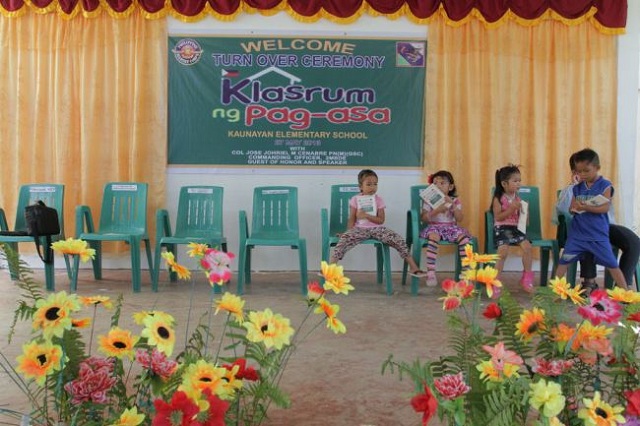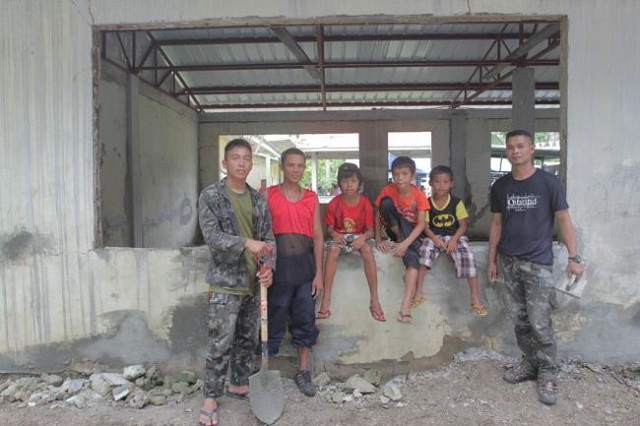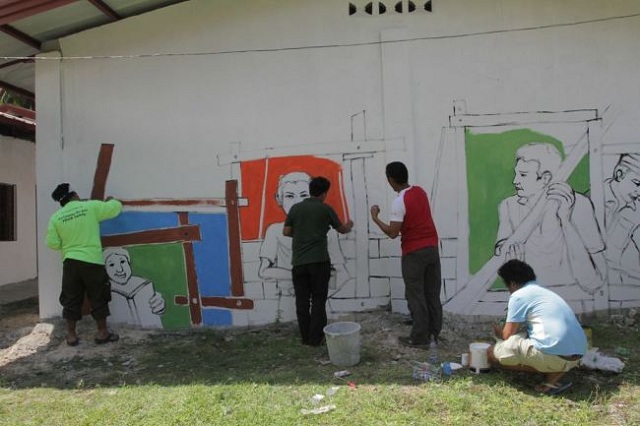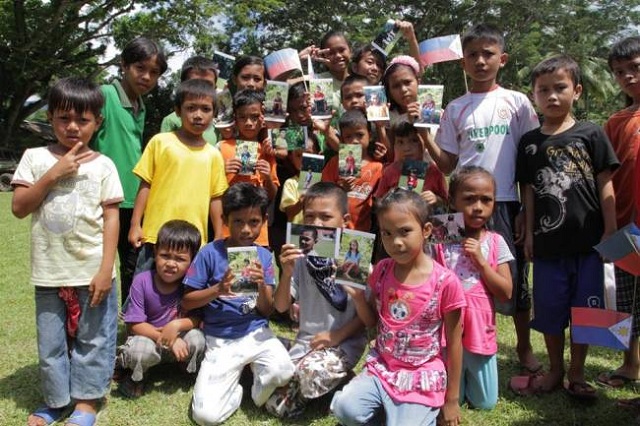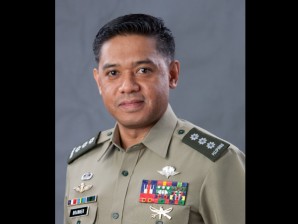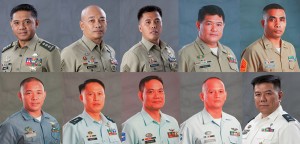From the Philippine News Agency (Jun 10):
16-day display of PHL flag caps 115th anniv of Independence
The 16-day display of the Philippine flag, attended by much fervor and a
sense of patriotism, winds up on June 12, the 115th anniversary of Philippine
Independence.
Displaying the country's tricolors from May 28 has become part of a revered
tradition and culture of this multi-ethnic, multi-lingual country of nearly 100
million people from Batanes to Tawi Tawi.
Sometime in the latter part of the 1960s, a young correspondent, covering a
news event in Sulu, saw this as the country's national anthem was played in
front of the capitol.
When the anthem was played by the military band, coinciding with the brisk
hoisting of the Philippine flag, the correspondent immediately realized the
indivisibility of this one nation as every Muslim and Christian in the audience
stood at attention.
But a question remains: How many of the population are familiar with the
specifics regarding the flag, despite the annual public display for 16 days,
called National Flag days?
The national flag, displayed with the blue field on top in times of peace,
and with the red field on top in times of war, is a horizontal bicolor with
equal bands of blue and red, and with a white equilateral triangle based at the
hoist side.
In the center of the triangle is a golden yellow sun with eight primary
rays, each containing three individual rays.
At every corner of the triangle is a five-pointed golden yellow star.
The flag is horizontally divided into two basic colors -- royal blue and
scarlet red -- with a white equilateral triangle based at the hoist side.
At the center of the triangle is a golden-yellow sun with eight primary
rays, each containing three individual rays, and at each corner of the triangle
is a five-pointed golden-yellow star.
The flag's length is twice its width, which translates into an aspect ratio
of 1:2. The sides of the white triangle are equal to the width of the flag.
Each star is oriented such that it points towards the tip of the vertex at
which it is located.
The flag's colors are specified by Republic Act 8491 in terms of their cable
number in the system developed by the Color Association of the
United States.
The Philippine flag, designed in 1897 by Emilio Aguinaldo while he was in
exile in
Hong Kong, is unique.
It can indicate a state of war when the red field is displayed on top, or on
the observer's left when the flag is displayed vertically, with the white
equilateral triangle at the top end.
According to official sources, the white triangle stands for equality and
fraternity; the blue field for peace, truth, and justice; and the red field for
patriotism and valor.
The eight primary rays of the sun represent the eight provinces which
declared a state of war as soon as the first revolt was initiated in the 1896
Revolution of independence from
Spain,
and placed under martial law by the colonial government.
The eight provinces were
Manila,
Cavite, Bulacan,
Pampanga, Nueva Ecija, Tarlac, Laguna, and Batangas.
The three stars represent the three major geographical divisions of this
Southeast Asian archipelago: Luzon, the Visayas, and
Mindanao.
Some have noted that the symbolism given in the 1898 Proclamation of
Philippine Independence differs from the current official explanation.
One school of thought says the white triangle signifies the emblem of the
Katipunan.
This is the secret society that opposed Spanish rule which was ushered in by
Fernando Magallanes in 1521 until the Spanish armada was beaten by the troops
of U.S. Admiral George Dewey in 1898.
Another school of thought says the flag's colors celebrate the flag of the
United States
as a manifestation of Philippine gratitude for American protection against the
Spanish during the Philippine Revolution.
Still another says that one of the three stars represents the
island of
Panay,
not the entire
Visayan islands.
Historians say it has been common since the 1960s to trace the development
of the Philippine flag to the various war standards of the individual leaders
of the Katipunan.
This was a pseudo-masonic revolutionary movement that opposed Spanish rule
in the
Philippines
and led the Philippine Revolution.
But while some symbols common to the Katipunan flags would be adopted into
the iconography of the Revolution, historians say it is inconclusive whether
these war standards can be considered precursors to the present Philippine
flag.
The first flag was sewn by Marcela Marino de Agoncillo with the help of her
daughter Lorenza and Delfina Herbosa de Natividad (a niece of reformist leader
José Rizal).
Agoncillo's remains are interred at the Dominican-run Sanctuario del Santo
Cristo in
San Juan
City.
The flag, while it was displayed in battle on May 28, 1898, was formally
unfurled during the proclamation of independence on June 12, 1898 in Kawit,
Cavite.
The flag was first flown with the red field up on Feb. 4, 1899 to show that
a state of war existed.
Aguinaldo was captured by the Americans two years later in Palanan, Isabela,
and swore allegiance to the
United
States.
The defeat of the Philippine Republic ushered in American colonial rule
which made the display of the Philippine flag an illegal move by the Sedition
Act of 1907.
This law was repealed on Oct. 30, 1919. With the legalization of the
Philippine flag, the cloth available in most stores was the red and blue of the
flag of the
United States,
so the flag from 1919 onwards adopted the navy blue color.
The Philippine Legislature passed Act. No 2928 on March 26, 1920, which
legally adopted the Philippine flag as the official flag of the Philippine
Islands.
Up until the eve of World War II, Flag Day was celebrated each year on
October 30, commemorating the date the ban on the flag was lifted.
On March 25, 1936, following the inauguration of the Commonwealth of the
Philippines in
the previous year, President Manuel L. Quezon issued Executive Order No. 23
which provided for the technical description and specifications of the flag.
The flag was once more banned with the Japanese invasion and occupation of
the
Philippines beginning in
December 1941, to be hoisted again with the establishment of the
Japanese-sponsored Second
Republic of the
Philippines.
During ceremonies in October 1943, Emilio Aguinaldo hoisted the flag with
the original Cuban blue and red colors restored.
The flag was initially flown with the blue stripe up, until President Jose
P. Laurel proclaimed the existence of a state of war with the Allied Powers in
1944.
The Commonwealth government-in-exile in
Washington, D.C.
continued to use the flag with the American colors, and had flown it with the
red stripe up since the initial invasion of the Japanese.
With the combined forces of the Filipino and American soldiers and the
liberation of the
Philippines
in 1944 to 1945, the flag with the American colors was restored.
This flag was hoisted when Philippine independence was restored -- not
granted, as some historians say -- on July 4, 1946.
In 1985, President Ferdinand Marcos ordered the colors of the flag restored
to the original blue and red of the Cuban flag.
But this act was reversed after the largely peaceful Catholic Church-backed
People Power Revolution removed Marcos from power.
For the 1998 centennial of the proclamation of Philippine independence, the
Flag and Heraldic Code of the
Philippines
(RA 8491) was passed, changing the shade of blue to royal blue.
The flag, often referred to as the tricolors -- although there are actually
four colors: white, blue, red, and the gold yellow of the sun and stars -- is
flown at half-mast as a sign of mourning.
Upon the official announcement of the death of the President or a former
President, the flag should be flown at half-mast for 10 days.
It should be flown at half-mast for seven days following the death of the
Vice President, the Chief Justice, the President of the Senate or the Speaker
of the House of Representatives.
The flag may also be required to fly at half-mast upon the death of other
persons to be determined by the National Historical Institute, for less than
seven days.
The flag shall be flown at half-mast on all the buildings and places where
the dead was holding office, on the day of death until the day of interment of
an incumbent member of the Supreme Court, the Cabinet, the Senate or the House
of Representatives, and such other persons as may be determined by the National
Historical Institute.
Under the law, when the flag is flown at half-mast, it should be first
hoisted to the peak for a moment then lowered to the half-mast position.
It should be raised to the peak again before it is lowered for the day.
The flag may also be used to cover the caskets of the dead of the military,
veterans of previous wars, national artists, and outstanding civilians as
determined by the local government.
In such cases, the flag must be placed such that the white triangle is at
the head and the blue portion covers the right side of the casket.
The flag should not be lowered to the grave or allowed to touch the ground,
but should be solemnly folded and handed to the heirs of the deceased.
It is prohibited to deface or ridicule the flag, to dip the flag as a
salute, or to add additional marks of any nature on the flag.
It may not be used as a drapery, festoon, tablecloth, as a covering for
objects, or as part of a costume or uniform.
Several commercial uses of the flag are prohibited, including using the flag
as a trademark or for commercial labels or designs.
It is forbidden to use the image of the flag on merchandise, or in any
advertisement.
It also may not be used as a pennant in the hood, side, back and top of
motor vehicles;
The flag may not be displayed horizontally face-up, or under any painting,
picture or platform.
http://www.pna.gov.ph/index.php?idn=&sid=&nid=&rid=532792

